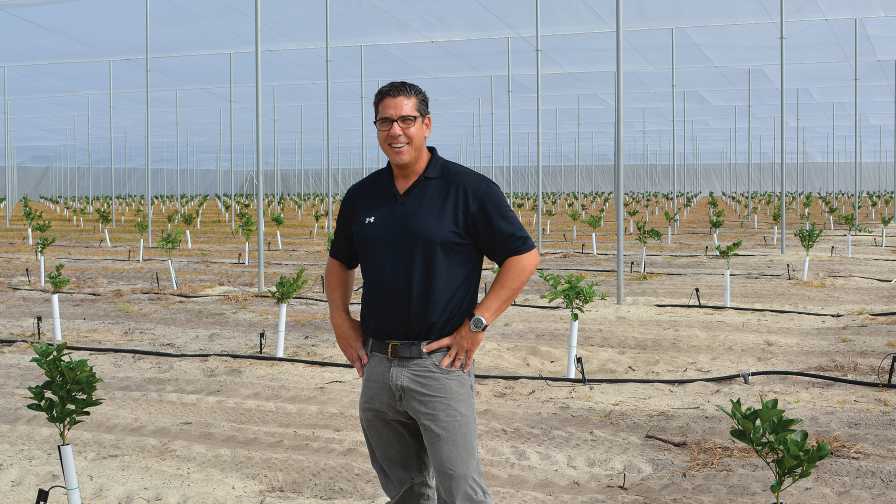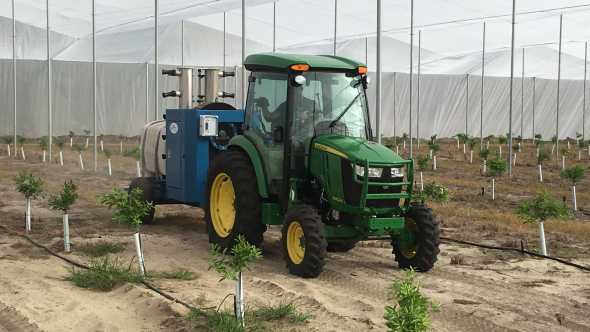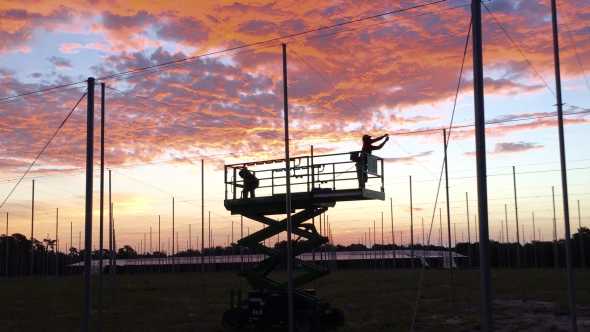Planting Citrus Under Protective Screen Goes Commercial

Ed Pines believes the future of Florida citrus is inside. He has planted 20 acres under screen near Lake Wales, FL.
Photo by Frank Giles

Long-standing assumptions about growing citrus in Florida were shattered by the Asian citrus psyllid and the HLB it spread to groves throughout the state. The amount of care trees receive today would have been unheard of pre-HLB as growers try to keep trees from experiencing yield-reducing stress.
The disease has forced change and new approaches to growing. While those efforts have likely stemmed the decline of groves, production has steadily fallen in the decade of greening. Researchers and growers continue to seek out new ways to survive in this disease-endemic environment.
One concept that would have been considered radical 10 years ago — planting citrus under protective screening (CUPS) — is now moving from the research stage into a commercial setting. Citrus grower Ed Pines has planted 20 acres under screen near Lake Wales.
The seed was planted for the CUPS project when Pines saw a presentation on a research paper authored by UF/IFAS scientists Arnold Schumann, Brian Boman, and Barrett Gruber that detailed how growing under screen might be a way to exclude the psyllid and greening from a citrus grove.
“As I listened to the presentation, my first instinct was to wonder what in the world are they talking about planting citrus under a protective structure,” Pines says. “But, I have a degree in construction management and engineering, so I was interested in what they were presenting.”
Pines began studying the concept and worked closely with Schumann, observing his one-acre test screen structure at the Citrus Research and Education Center in Lake Alfred. As he learned more, he realized CUPS really should be looked at beyond its ability to exclude HLB.
“Florida’s population is going to continue to grow and the expansion of the Panama Canal will mean even more imports coming into the state,” he says. “That might be good for the state’s economy, but it also brings more challenges with new pests and diseases being introduced here.
“Brazil has citrus variegated chlorosis (CVC) and Florida already has the sharpshooter, which is the vector of the disease. It is probably only a matter of time before we see CVC here. The structure will exclude the sharpshooter and other pests like the citrus leafminer and Diaprepes.”
Pines says another selling point for CUPS is consumer demand for more sustainable growing practices. In fact, major retailers have visited Pines’ CUPS planting and are excited about the project.
“Consumers want a product that is grown in a more environmentally friendly way using less water, less chemicals, less fertilizer, and no bactericides,” he says. “Using a CUPS system, we can do this.”
Pines says he believes the citrus industry will continue to evolve with large orange juice growers consolidating even more to absorb the high expense that is now necessary to grow citrus. Fresh fruit growers outside will continue to be challenged by costs and declining production due to HLB and other pests and diseases. Then, there will be a place for CUPS where growers will have more certainty surrounding the production of high-value varieties.
Marketing Considerations
Pines is a long-time member/grower with the Dundee Citrus Growers Association. He has worked closely with the association in developing the CUPS idea. Pines and the association’s leadership traveled to Central America to investigate a large planting there in order to learn about and develop a structure that is capable of withstanding Florida’s unique climate.
“Once we decided to pull the trigger on the project, Dundee Citrus Growers Association has been very instrumental in sharing ideas on what types of fruit to plant and managing costs,” Pines says. “They are very interested in the concept because they see it as a way to produce high-quality fruit for the long term.”
Dundee will market the fruit produced by Pines. The two varieties planted under the protective structures are easy-peel, seedless mandarins ‘Tango’ and ‘Early Pride.’ Plantings under the CUPS system can also claim sustainability and excellent food safety, which will only enhance the marketability of the fruit.
More Than HLB
Much of the discussion surrounding CUPS has been in regard to excluding the psyllid and therefore HLB. Beyond excluding key pests in citrus, the system provides other benefits that can help growers recoup on their higher up-front investments in establishing a planting under cover.

Smaller, less expensive equipment is needed when growing citrus under protective screen structures.
Photo courtesy of Ed Pines
For fresh fruit, the screen helps reduce sunburn because the 50-mesh netting diffuses the sunlight entering the structure. In addition, the screen helps reduce wind scar on the fruit. There is less water required to grow the trees because there is less evaporation under the screen.
“This is a very common method of growing around the world because there are a lot benefits to the system,” Pines says. “We just have never tried it in citrus because we didn’t have to, but HLB has forced us to change.”
Reduced expenses on equipment is another area growers can benefit from CUPS. For Pines’ 20-acre planting, only one 40-horsepower tractor and one pull-behind air blast sprayer are needed. For transportation, one John Deere Gator fits the bill.
“You start looking at all of these indirect costs and savings on less and smaller equipment and the associated fuel savings, it begins to add up,” Pines says. “We are used to farming these big tracts of land for fresh and juice fruit, but with CUPS, we are downsizing the footprint of the farm. But, you have to realize you are going to be making about four times the production on one acre of land under cover versus four acres planted outside.”
According to Pines, growers can expect commercial scale production within three years of planting. By the fifth season, a well-managed planting could expect yields as high as 800 boxes per acre with a 95% pack-out.
“Farm Credit of Central Florida has financed the project,” Pines adds. “They like this concept because we have eliminated the biggest threat, which is HLB. They know Florida’s climate and soils can produce high yields and great quality fruit if we take this disease out of the equation.”

Weather stations track soil moisture, rain, wind, and humidity to help guide production decisions.
Photo by Frank Giles
Managed To Grow
Another important aspect to a CUPS system is managing citrus to grow rapidly. Pines planted the citrus in August, and within weeks, trees were off and running. He attributes the fast growth to the controlled environment under the screen, higher tree density (340 trees per acre), as well as intensive fertigation. Irrigation will be guided by weather stations installed in both screen structures.
“We do a lot of tissue and soil samples and base our fertigation program on that information,” he says. “We feed the trees once a week with liquid fertilizer. Our nutritional program is almost entirely based on fertigation.”
Pines is working closely with Yara International to develop a nutritional program specifically for citrus grown under screen.
“We have expertise working with these CUPS growing systems all over the world,” says Eric Waldo, Regional Marketing Manager for Yara. “We are excited to be a part of this citrus project in Florida to help develop an optimal nutrition program for this approach.”
Pines elected to plant his tree in the ground rather than in pots as often is the case with CUPS. He says the minerals in the soil will impart the “Florida taste” that has been missing since HLB came on the scene and distorted fruit flavor.
“We also can go back to growing trees the way we used to,” Pines adds. “We can turn off the water and fertilizer to force an optimum, uniform bloom. Outside, we can’t do that anymore because we can’t afford for the trees to be stressed from lack of water or fertilizer.”
The plantings are scouted weekly for pests and disease. If pests are found, sprays will be made to control problems. Sticky traps also are used to monitor for the psyllid. To date, no psyllid has been found under the structures. Forced air entrances are aimed at keeping the psyllid and other pests at bay when people enter or exit the structures. And, access in and out of the structures is strictly monitored.
Pines says it is exciting to see the work of Florida researchers come to fruition in a commercial-scale project like his.
“Now that people see the installation in place, excitement is building,” he says. “Most people don’t like change, but with HLB we have to. We are seeing CUPS can be viable. The numbers work and it will be a part of the future landscape of Florida citrus.”

Ed Pines’ screen structure near Lake Wales, FL, will exclude the psyllid and other key pests.
Photo by Frank Giles
Here’s a look at some of the specifications of Ed Pines’ protected citriculture planting.
- Size: 20 acres under two structures
- Structure: 20-foot galvanized poles anchored by concrete. Screen is secured with sturdy wire cables.
- Screen: 50-mesh.
- Varieties: ‘Tango’ and ‘Early Pride’
- Density: 340 trees per acre
- Insurability: Because structures are constructed under a certified engineering protocol, they are insurable. Structures are rated to 80 mph winds.

Photo courtesy of Ed Pines
Built To Specs
Pines believes planting citrus under protective screen (CUPS) will be a viable part of Florida’s citrus industry. In addition to his own planting, he has created Precision Citrus LLC. The new company is a licensed distributor for ULMA Agricola and will consult with growers and build a CUPS facility to a grower’s specific needs.
“Every structure we build for growers will be based on their needs, location, and goals for productivity,” he says. “They will be engineered for Florida’s climate.”










